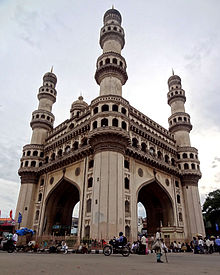This section needs additional citations for verification. (June 2018) |

The culture of Hyderabad, also known as Hyderabadi Tehzeeb (حیدرآبادي تہذیب ) or Dakhini Tehzeeb (دکني تہذیب ),[1] is the traditional cultural lifestyle of the Hyderabadi Muslims, and characterizes distinct linguistic and cultural traditions of North and South India, which meet and mingle in the city and erstwhile kingdom.[2] This blending was the result of the geographic location of the region and the variety of historical dynasties that ruled the city across different periods—its inception by the Qutub Shahi dynasty in 1591 AD, the occupation by the Mughal Empire and its decline, and the patronage under the Asaf Jahi dynasty.

The city is historically known for its Ganga-Jamuni tehzeeb, which refers to unity and co-existence of Hindu and Muslim cultures and traditions. Apart from a few instances of communal violence, the majority of the city residents advocate communal harmony between Hyderabadi Muslims and Telugu people, the two main religious and cultural groups found in the city.[3][4][5][6]
Apart from Hyderabad, Hyderabadi Culture is also seen in communities in Bidar, Vijayawada, Gulbarga, Bijapur, Guntur, Latur and Aurangabad. These used to be a part of the erstwhile Hyderabad State, hence, the culture is prevalent in the areas, especially among Dakhini Muslims.
Hyderabadis, as residents of the city are known, may be either Urdu or Telugu speaking. [7] The traditional Hyderabadi garb is Sherwani Kurta Paijama, and Lungi for men,[8] Sarees, Khara Dupatta and Salwar kameez for women.[9][10] Burqa and Hijab is commonly practised among the Muslim women in public.[11] Most of the youth wear western clothing.[12] Public carnivals celebrated in Hyderabad include the , [13] Ganesh Chaturthi,[14] Bonalu, Eid ul-Fitr and Eid al-Adha, Milad Un Nabi
- ^ "Deccani tehzeeb symbol of Ganga jamnawi tehzeeb is history". The Times of India. 16 December 2011. Archived from the original on 17 December 2013. Retrieved 4 November 2012.
- ^ "Hyderabad through the eyes of a voyager". The Times of India. 24 July 2011. Archived from the original on 6 November 2012. Retrieved 27 December 2011.
- ^ "585 Narendra Luther, Bridging two cultures". www.india-seminar.com. Retrieved 5 August 2018.
- ^ "KCR vows to get 'Ganga Jamuni tehzeeb' back". The Hindu. 13 July 2015. ISSN 0971-751X. Retrieved 19 July 2018.
- ^ "Muslims keep alive spirit of Ganga-Jamuni tehzeeb - Times of India". The Times of India. Retrieved 5 August 2018.
- ^ "Ganga-Jamuni tehzeeb: Temple serving Iftar Dates to 5 Mosques in Hyderabad | The Siasat Daily". archive.siasat.com. Retrieved 5 August 2018.
- ^ "Languages". Government of Andhra Pradesh. 2011. Archived from the original on 8 February 2012. Retrieved 14 April 2012. "Common Expressions: Hyderabadi Urdu". Webster's Online Dictionary. 2011. Archived from the original on 18 January 2012. Retrieved 14 April 2012.
- ^ "Alkesh and Saranya's engagement do". The Times of India. 21 June 2011. Archived from the original on 3 January 2013. Retrieved 22 April 2012.
- "Clothes make-over for men". The Hindu. 21 March 2002. Archived from the original on 23 May 2002. Retrieved 22 April 2012.
- ^ Karen Isaksen Leonard (2007). Locating home: India's Hyderabadis abroad. Stanford University Press. pp. 14 and 248–255. ISBN 978-0-8047-5442-2.
- ^ "Ramzan shopping reaches peak". The Hindu. 2 September 2010. Retrieved 14 April 2012.
- "Retro chic". The Hindu. 17 November 2004. Retrieved 14 April 2012.
- ^ "Burqa sale on the rise in Old City". The Times of India. 28 December 2010. Retrieved 14 April 2012.
- ^ "Efforts should be made to preserve traditional wear". The Hindu. 23 March 2009. Archived from the original on 10 November 2013. Retrieved 14 April 2012.
- ^ "Gaiety marks Id-ul-Fitr celebrations". The Hindu. 15 November 2004. Archived from the original on 25 November 2004. Retrieved 14 April 2012.
- ^ "Tight security for Ganesh festival in Hyderabad". Sify. 11 September 2010. Archived from the original on 4 December 2011. Retrieved 14 April 2012.
© MMXXIII Rich X Search. We shall prevail. All rights reserved. Rich X Search
